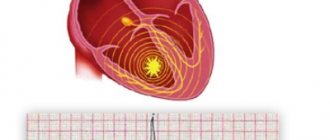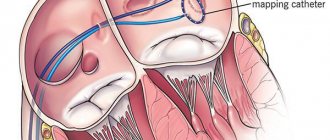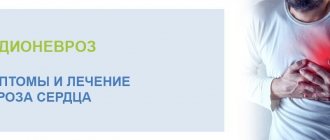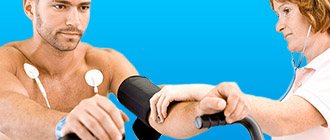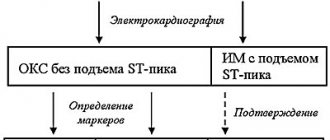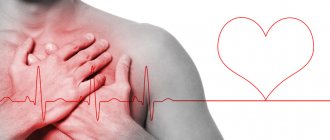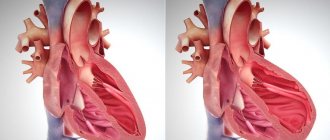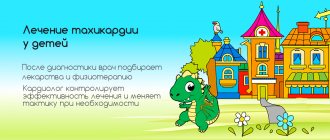What is cardiac extrasystole?
During normal heart function, the main driver of the heart rhythm is the sinus node, and the heart rate is 60-80 beats per minute. With extrasystole, extraordinary electrical impulses occur. This leads to the appearance of extrasystoles - premature contractions of the heart or its individual chambers that do not fit into the overall heart rhythm.
During an extraordinary contraction, the myocardium pumps less blood than during normal contraction of the heart. In this regard, frequent extrasystoles negatively affect blood circulation, in particular coronary and cerebral blood flow.
Examples of diagnosis formulation:
WPW syndrome, frequent paroxysms of supraventricular tachycardia (up to 2-3 times a month).
DCM, complete block of the left bundle branch, frequent polytopic ventricular extrasystoles, CHF II B, FC III. Cardiac asthma.
- Single polymorphic ventricular extrasystole
3. IHD: exertional angina, FC III. Post-infarction cardiosclerosis (with Q wave, infarction, date, localization). SSSU corrected with a pacemaker (date). CHF II A, cardiac asthma.
Background: Stage III hypertension, stage 2 hypertension, risk 4.
4. IHD: progressive angina. PIX (date, location), aneurysm of the anterior wall of the left ventricle. Incomplete AV block II degree (Mobitz II), CHF III, FC IV.
What are the types of extrasystoles?
Depending on the place of occurrence of extraordinary contractions, extrasystoles are:
- ventricular;
- atrial;
- atrioventricular (nodal).
In rare cases, extraordinary impulses are generated by the sinus node.
Parasystoles are also distinguished, which are characterized by parallel work of an additional cardiac pacemaker (for example, atria, ventricles) and the sinus node. In such cases, there are 2 rhythms simultaneously: sinus and extrasystolic.
Depending on the time of occurrence of extraordinary contractions of the heart, extrasystoles are divided into:
- bigeminy - every normal, physiological contraction of the myocardium is accompanied by a pathological contraction;
- trigeminy - two normal myocardial contractions are followed by one extraordinary contraction;
- quadrigeminy - a pathological contraction follows every three physiological contractions of the myocardium.
A phenomenon in which three or more pathological contractions occur in a row is called “unstable paroxysmal tachycardia.” Such arrhythmia is quite dangerous and indicates severe electrical instability of the heart muscle.
The pathology is characterized by a heart rate from 140 to 220 beats per minute.
Classification of ventricular extrasystoles
Under certain circumstances, ventricular extrasystole causes a severe form of arrhythmia - ventricular tachycardia, which turns into fibrillation. And this condition is the most common cause of sudden coronary death.
Lown classification
The classification of PVCs has changed several times following diagnostic and prognostic needs. Extrasystoles in them were distributed according to quantitative values, location and frequency of occurrence. For about 15 years in cardiology they used the classification of ventricular extrasystoles according to Lown and Wolf (B. Lown and M. Wolf). They proposed it for the gradation of gastric extrasystoles in post-infarction patients. A few years later, it was adapted for patients without a history of heart attack.
This classification reflects the quantitative and morphological signs of PVCs (based on the results of a 24-hour ECG):
| Class | Characteristics of ventricular extrasystole |
| Extraordinary layoffs are not recorded | |
| 1 | Less than 30 single extrasystoles in any 60 minutes during the day |
| 2 | More than 30 single extrasystoles during any hour of monitoring |
| 3 | There are (polymorphic) extraordinary contractions occurring in different foci of excitation |
| 4A | There are two extrasystoles in a row emanating from one focus of excitation (monomorphic) |
| 4B | There are paired polymorphic extrasystoles |
| 5 | There are polymorphic PVCs passing in one gulp of 3–5, registration of paroxysmal ventricular tachycardia is possible |
According to Lown's classification, class 1 is a benign condition, rather considered as a functional disorder without circulatory impairment and clinical signs. Starting from class 2, ventricular extrasystole has a poor prognosis, being associated with an increased risk of developing fibrillation and cardiac arrest.
Gradation of extrasystoles by location, time and frequency of occurrence
There is a classification of ventricular extrasystole according to the place of origin of impulses and the number of foci of excitation:
- extrasystoles emanating from one focus are called monotopic;
- PVCs that originate in several foci are polytopic;
- right ventricular extrasystole;
- left ventricular extrasystole.
According to the time of occurrence, ventricular extrasystoles are divided into early (recorded at the beginning of diastole), interpolated, appearing in the middle between two beats, and late, occurring at the very end of diastole. Early extraordinary contractions according to the ECG sign are called “R on T” (layering of two teeth on top of each other). They are caused by organic changes in the myocardium. According to Lown, this type of ventricular extrasystole is classified as class 5.
In cardiology, there is a concept of a statistical daily “norm” of VES if they are well tolerated. There is no such norm for early extrasystole - it should not exist at all. Average or interpolated is the majority of the VES (up to 80%). Its average normal indicator is considered to be up to 200 extraordinary contractions per day. Late extrasystoles almost overlap the subsequent normal contraction. Their permissible daily quantity is up to 700. Today, the medical community uses the RJ Myerburg classification, which reflects the shape and frequency of ventricular extrasystoles:
| By frequency | According to morphology | ||
| 1 | less than 1 in 60 minutes - rare; | A | Single from one source |
| 2 | 1–9 per hour - infrequent; | B | Single from different foci |
| 3 | 10–30 per hour – moderately frequent; | C | Doubles |
| 4 | 31–60 per hour - frequent; | D | Unsustained ventricular tachycardia |
| 5 | more than 60 per hour - very frequent. | E | Sustained ventricular tachycardia |
Causes of extrasystole
The danger of extraordinary heart contractions directly depends on the reason for which they occurred. Today, extrasystoles are distinguished:
- functional origin, when the heart is not affected by pathologies;
- organic origin, which are associated with structural disorders of the heart. It is organic extrasystoles that are pathological and pose a threat to health.
Functional extrasystoles can be a consequence of:
- cervical osteochondrosis;
- neuroses, stress;
- neurocirculatory dystonia - a functional pathology that is associated with an imbalance in the functioning of the autonomic nervous system;
- drinking a lot of coffee;
- bad habits - smoking, alcohol abuse;
- taking certain medications - bronchodilators, psychotropic drugs, glucocorticoids, diuretics.
Also, extrasystoles can occur for no apparent reason. The heart makes more than 100 thousand contractions per day, so it is difficult to imagine that all of them are rhythmic. In this regard, extraordinary cardiac contractions may well be a variant of the norm.
The reasons for the appearance of organic extrasystoles include:
- cardiosclerosis - proliferation of connective scar tissue in the myocardium;
- coronary heart disease - a discrepancy between the myocardial need for oxygen and its delivery to the heart muscle;
- previous myocardial infarction;
- cardiomyopathies - mechanical or electrical dysfunction of the heart muscle;
- thickening of the myocardial walls;
- congenital and acquired heart defects;
- inflammatory processes of the myocardium;
- cor pulmonale - enlargement and expansion of the right parts of the myocardium as a result of increased blood pressure in the pulmonary circulation. The pathology is a complication of lung disease or chest deformation;
- some systemic diseases that affect the heart;
- surgical operations on the myocardium;
- arterial hypertension.
Emergency first aid
An approximate algorithm of actions is as follows:
- Assess the objective state of a person. To do this, just touch him, ask a question, call out to him. There is no reaction during asystole, it is impossible to return the victim to consciousness.
- Place the person on his back, throw back his head, push his lower jaw forward, open his mouth slightly. These measures will prevent tongue retraction, asphyxia and improve ventilation after lung function is restored.
- Check respiratory activity. Using a mirror or listening. Duration no more than 3-7 seconds.
In case of absence, an ambulance is called.
Before arrival, you should at least try to stabilize the patient’s condition and restore some of the body’s functions.
What is required for this:
- Heart massage. Place one open palm on the middle of the chest, the other on it. Straighten your elbows. Press firmly on the area with rhythmic short movements. Speed - approximately 120 per minute.
- Artificial respiration is not performed without special preparation, since there will be no effect. It's better to concentrate on the massage. If first aid experience is present, every 10-30 movements are accompanied by two breaths.
If cardiac activity is successfully restored, you need to turn the victim's head to the side to prevent choking on vomit. Once the doctors arrive, all activities stop.
Competent early interventions can increase a person's chances of survival. Resuscitation for asystole is carried out in an ambulance, also in a specialized department of the hospital.
Diagnostic methods
A cardiologist may suspect the presence of extrasystole in a patient during a physical examination and history. When collecting an anamnesis, the clinical manifestations of arrhythmia are clarified, at what time and under what circumstances unpleasant symptoms occur (at rest, during physical activity).
The main method for diagnosing extrasystole is ECG , which allows not only to identify the deviation itself, but also to determine the type and number of extraordinary heart contractions.
In addition, the patient may be prescribed other types of examination:
- daily ECG monitoring, which will give a more complete picture of the disease and will allow you to determine the percentage of extrasystoles in relation to normal heart contractions;
- electrocardiography with exercise - bicycle ergometry, treadmill test;
- ultrasound examination of the heart;
- MRI of the heart;
- biochemical blood test for electrolytes.
Case from practice
A patient came to see me with a feeling of interruptions in the heart; during the attack, the extremities became cold, the pressure increased to 150/95 mm Hg. Art. There is no history of cardiac pathology. Indicates a worsening of arrhythmia with physical activity and alcohol intake. The ECG showed no deviation; after Holter monitoring, episodes of volley extrasystoles from the right ventricle were detected. After prescribing sedatives and a beta blocker (Bisoprolol), the patient was discharged after two weeks with improvement.
Treatment of extrasystole
Treatment of pathology is carried out in the following cases:
- if extrasystoles account for more than 20% of the total number of heartbeats;
- if the patient has severe symptoms.
Episodic functional extrasystoles that are asymptomatic do not require treatment.
Today there are two methods of treating extrasystole:
- Drug treatment. The patient may be prescribed antiarrhythmic drugs, beta-blockers and other medications.
- Radiofrequency ablation is a surgical treatment method in which the site of extraordinary heart contractions is destroyed using a special electrode. Accordingly, after the operation the person completely gets rid of extrasystole.
Expert advice
Detection of ventricular extrasystoles on an ECG is not yet a sign of a serious problem and does not require special treatment.
Functional rhythm disturbances are often accompanied by symptoms that do not correspond to the severity of the condition. To eliminate them, it is enough to remove alcohol from your diet, quit smoking and drink caffeinated drinks. Among the drugs you can drink valerian tincture, Corvalol. When extrasystole is accompanied by coronary disease or other disorders, you must immediately contact a cardiologist and undergo a full examination. All medications should be taken as scheduled and should never be discontinued on your own.
Prognosis and possible complications
As a rule, with functional extrasystoles the prognosis is positive. With organic extrasystoles, the prognosis depends on the timeliness of diagnosis and treatment. If treatment is started at the wrong time, organic extrasystole can lead to serious complications:
- atrial fibrillation - chaotic contraction of the atrial myocardium. In turn, atrial fibrillation often ends in heart failure;
- ventricular fibrillation, in which there is low cardiac output, arterial hypotension and loss of consciousness. Pathology causes sudden cardiac death in 70-80% of cases.
Features of asystole in children
All of the above reasons apply to children, but an important difference from adults is a special type of asystole, which is included in the general concept of “sudden infant death syndrome.” In this case, cardiac arrest is recorded in a child more often under the age of 5 months against the background of sleep and the absence of any diseases during this period.
It is believed that ventricular asystole in a baby is caused by underdevelopment of myocardial cells, impulse transmission pathways. Perhaps it is associated with the pathological course of pregnancy and labor in the mother:
- hypoxia (lack of oxygen) in the fetus due to anemia, diseases of the maternal body;
- asphyxia during childbirth;
- vacuum extraction of the fetus;
- multiple pregnancy;
- the birth of a premature baby;
- smoking and alcohol consumption by the expectant mother.
Contributing factors are:
- placing the baby on a soft mattress;
- unventilated hot room;
- many blankets covering the child and causing him to overheat;
- tight swaddling.
Sleeping in the prone position is one of the risk factors for asystole
Many causes of death in a newborn due to asystole are associated with the lack of proper care for the child by adults.
The most popular antiarrhythmic drugs
Pharmacies provide a wide range of antiarrhythmic drugs. The choice of a suitable remedy is determined by the patient’s condition and the results of his examination. In addition, during therapy, it is possible to replace the selected medication with one of its analogues if the effect of its use is insufficient. Among the most common drugs that are easy to find in pharmacies and which have proven themselves in the treatment of extrasystole, several options can be distinguished.
- Amiodarone (Cordarone) - combines the properties of all 4 groups of antiarrhythmic drugs and is available in tablet form. It is considered one of the most effective options. Its frequent use may cause side effects such as impaired functioning of the kidneys, liver and thyroid gland.
- Sotalol (Sotahexal) is a typical beta blocker, sold in tablet form. It is recommended to begin its use in a hospital setting, but it is also suitable for home use.
- Novocainamide is a drug from the group of sodium channel blockers. Its active ingredient, procainamide, belongs to subgroup IA. The product is available in the form of ampoules or tablets, suitable for use in inpatient and outpatient settings.
- Quinidine (Kinidin Durules) was previously the main antiarrhythmic drug. It is available in the form of tablets of 0.2 g and is easily tolerated in small dosages (up to 0.6–0.8 g). The product is made from the bark of the cinchona tree and exhibits the properties of sodium channel blockers.
Antiarrhythmic drugs used for extrasystole are a large group of drugs with different compositions and mechanisms of action. Despite the fact that this symptom is not dangerous and can be treated without treatment, medications should only be taken under the supervision of a doctor. The difficulty lies not only in selecting the most suitable substance and its dosage, but also in the need to regularly conduct examinations to prevent side effects.
Prevention
The consequences of ventricular extrasystoles can be extremely dangerous, even fatal, so their prevention is important. It includes:
- Maintaining a healthy lifestyle. It is necessary to maintain a daily routine, allocate enough time for sleep and rest, and avoid excessive physical and emotional stress;
- Balanced diet. You should not eat a lot of fried, salty, spicy foods. It is useful to include foods containing large amounts of fiber in your diet;
- Rejection of bad habits. Alcohol and smoking aggravate many diseases of the cardiovascular system;
- Periodic examination of the body. It is necessary to consult a doctor in a timely manner if any complaints arise, and also periodically undergo age-related medical examinations;
- Treatment of diseases, compliance with all doctor’s prescriptions. You should not treat diseases yourself, using folk remedies, or voluntarily cancel or change the dosage of medications prescribed by a cardiologist.
Clinical manifestations
Symptoms of cardiac arrest are characterized by a sudden death clinic and are accompanied by respiratory arrest. Let's consider possible options for the conditions for detecting a patient.
- Option 1 - an outwardly ordinary person at work or on the street, in transport suddenly falls, hoarse, rare breathing escapes from the throat, lips and face turn blue, there is no consciousness, attempts to make contact are unsuccessful.
- Option 2 - fatal cardiac arrest occurs during sleep, and the patient lies down and looks like a normal sleeping person. Those around him do not immediately notice his lack of any reactions.
In both cases, the patient does not have time to call for help or complain about deteriorating health.
- Option 3 - the patient is being treated in a specialized department for heart disease in a general ward, he is allowed to walk, or he forces the regime on his own. He can fall in the corridor, in the ward, on the stairs. Symptoms correspond to clinical death.
- Option 4 - the patient is in the acute stage of a heart attack or with severe somatic lesions, trauma, is in the intensive care unit, the condition is monitored by a monitor, the ECG picture is constantly monitored, any deviation in the rhythm activity is indicated by a sound signal.
The last option is the most favorable in terms of providing the necessary assistance.
Doctors in a specialized department do not need to waste time searching for a pulse; all equipment for resuscitation is usually at hand
Not every passerby can find the pulse on the carotid artery (at the angle of the lower jaw) or verify the absence of a heartbeat. Usually the first place is given to:
- loss of consciousness;
- pallor and cyanosis of the face;
- lack of breathing movements.
Symptoms
Ventricular extrasystole can be either asymptomatic or have severe symptoms. The most common patient complaints:
- Interruptions in the functioning of the heart - patients note increased heartbeat or, conversely, the heart seems to be freezing. Often these two symptoms are combined: at first the heart seems to freeze, and immediately after that it contracts intensely;
- Cardiopalmus;
- Frequent dizziness;
- Weakness;
- Symptoms of ventricular extrasystole include discomfort in the heart area, sometimes painful;
- Pulsation of the neck veins - this occurs when the atria contract, but the atrioventricular valves are closed, since the ventricles of the heart have also contracted prematurely;
- If extrasystoles occur frequently, the symptoms include fatigue, a feeling of lack of air, shortness of breath, and sometimes loss of consciousness.
Desirable algorithm for the action of a random passerby
Since a person’s life depends on the speed of first aid, any passerby must be able to navigate the indications and the severity of the victim’s condition.
Recommended:
- Stimulate the victim, shake him, slap him on the cheeks, speak loudly. If a person regains consciousness, this indicates a short-term disturbance of cerebral circulation. Accordingly, you need to try to ensure free breathing, a position with a low head end.
- If there is no reaction to the intervention, then you should try to feel the pulsation of the carotid artery, if it is impossible to listen to the heartbeat, by placing your ear to the chest.
- You need to call for help. Someone must call an ambulance and help carry out emergency measures.
When you see a fallen person, you should not pass by; your family and friends may find themselves in the same situation.
